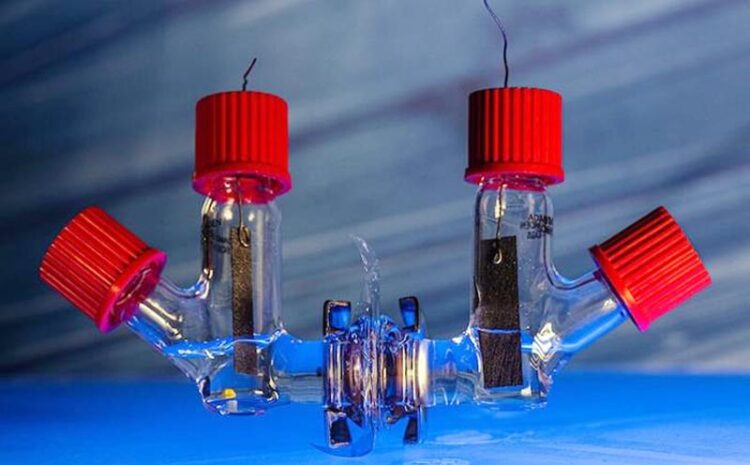Rice breakthrough could make automated dosing systems universal

A prototype electronic sensor that emits current when it detects the anticancer drug afimoxifene. Rice University synthetic biologists created the device to demonstrate a new method that could slash the costs of creating wearable monitors for precision, automated drug dosing of chemotherapies and other drugs. (Photo by Jeff Fitlow/Rice University)
Synthetic biologists’ hack blood-glucose reaction to create chemotherapy detector.
Rice University synthetic biologists have found a way to piggyback on the glucose monitoring technology used in automated insulin dosing systems and make it universally applicable for the monitoring and dosing of virtually any drug.
In a recently published study in Nature Communications, researchers in the lab of Caroline Ajo-Franklin demonstrated the technique by modifying a blood-glucose sensor to detect the anticancer drug afimoxifene , an estrogen inhibitor that patient’s bodies also make after they take the chemotherapy tamoxifen.
By building on mature biosensing technology that’s commercially available at most drug stores for under $20, Ajo-Franklin’s team hopes to speed the development of automated dosing systems for chemotherapies and other drugs as well as other technologies for real-time monitoring of biomarkers in the blood.
“The dream is to have technology similar to what’s available today for monitoring and treating variations in blood glucose, and have that be true for basically any drug,” said Ajo-Franklin, a bioscientist, cancer researcher and director of the Rice Synthetic Biology Institute . “Millions of people use blood-glucose monitors every day. If we can use that same basic technology to monitor other drugs and biomarkers, we could move away from the one-size-fits-all dosing regimes that we’re stuck with today.”
The heart of blood-glucose monitoring technology is a biochemical reaction in which specific proteins bind to glucose molecules and release electrons. Millions of these reactions take place within seconds, creating a small electrical current that is proportional to the amount of glucose in the blood sample.
Rong Cai , a postdoctoral research associate and the lead author of the study, tested more than 400 slightly modified versions of the electron-releasing protein and found a version that reacted with afimoxifene, reducing the current output from the glucose reaction in the blood. This allowed the team to detect the presence of afimoxifene by comparing the current produced by the regular glucose test to the reduced current from the modified test.
To demonstrate the technology in an electronic device, Ajo-Franklin’s team worked with the research group of Rice engineer and materials scientist Rafael Verduzco to create an afimoxifene sensor that emitted a current when the drug was detected.
Ajo-Franklin said her lab is already working on both ways to improve the sensitivity of glucose-based drug tests and methods to rapidly identify glucose-oxidizing proteins that can detect drugs other than afimoxifene.
“The glucometer is the part that’s so well-developed,” Cai said. “While our target is different, it’s just a matter of engineering and changing the protein on the inside. On the outside, everything will still be the same. You can still do the test with a strip or on your arm.”
She said another key feature of the technology is that it produces an electrical output.
“If your signal is electrical, you can read it in your phone, store its data in your phone, send it to the cloud, whatever,” Cai said. “That’s the part, that marriage between electricity and biology, that is very attractive.”
Ajo-Franklin is a professor of biosciences in the Weiss School of Natural Sciences and a CPRIT Scholar in Cancer Research with the Cancer Prevention and Research Institute of Texas (CPRIT). Verduzco is a professor of chemical and biomolecular engineering and of materials science and nanoengineering in the George R. Brown School of Engineering .
The research was supported by CPRIT (RR190063), the National Science Foundation (1828869, 2223678) and the Army Research Office (W911NF-22-1-0239).
by Jade Boyd
Special to Rice News
Media Contact
Marcy de Luna
Rice University
md115@rice.edu
Office: 7133486780
All latest news from the category: Materials Sciences
Materials management deals with the research, development, manufacturing and processing of raw and industrial materials. Key aspects here are biological and medical issues, which play an increasingly important role in this field.
innovations-report offers in-depth articles related to the development and application of materials and the structure and properties of new materials.
Newest articles

NASA: Mystery of life’s handedness deepens
The mystery of why life uses molecules with specific orientations has deepened with a NASA-funded discovery that RNA — a key molecule thought to have potentially held the instructions for…

What are the effects of historic lithium mining on water quality?
Study reveals low levels of common contaminants but high levels of other elements in waters associated with an abandoned lithium mine. Lithium ore and mining waste from a historic lithium…

Quantum-inspired design boosts efficiency of heat-to-electricity conversion
Rice engineers take unconventional route to improving thermophotovoltaic systems. Researchers at Rice University have found a new way to improve a key element of thermophotovoltaic (TPV) systems, which convert heat…



